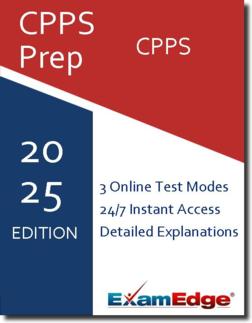CPPS Practice Tests & Test Prep by Exam Edge - Additional Information
Based on 25 Reviews
- Real Exam Simulation: Timed questions and matching content build comfort for your CPPS test day.
- Instant, 24/7 Access: Web-based Certified Professional in Patient Safety practice exams with no software needed.
- Clear Explanations: Step-by-step answers and explanations for your CPPS exam to strengthen understanding.
- Boosted Confidence: Reduces anxiety and improves test-taking skills to ace your Certified Professional in Patient Safety (CPPS).

Certified Professional in Patient Safety - Additional Information
What is the CPPS Exam?
The CPPS exam is for nurses and medical professionals who seek to be Certified Professionals in Patient Safety (CPPS). Created and administered by the Institute for Healthcare Improvement (IHI), CPPS certification signifies a high level of competency in patient safety matters. This helps nurses stand out for future jobs and improves the lives of patients by educating caregivers. At Exam Edge, we provide full packets of CPPS practice questions to help you ensure a high score on the test and achieve your CPPS certification.
What is on the CPPS Exam: Detailed Breakdown.
Are you preparing to take the CPPS exam? You'll need to understand the breakdown of the test, including the subject matter and style of its 50 questions. There are five core values or subjects that are tested by the CPPS IHI, and you'll need to be proficient in all of them to do well on the exam. CPPS exam questions cover everything from patient safety risks and culture to leadership and systems thinking.
The exam requires you to know key concepts like how to design and improve safety procedures for organizations, how to respond to patients and reduce risk, how to analyze the effectiveness of an organization's protocols, and how to lead patient safety initiatives. In fact, the IHI reports that four-fifths of the over 4,000 nurses who have obtained CPPS certification have gone on to lead initiatives in their healthcare organizations and improve patient outcomes.
How is the CPPS Test Scored?
Using the Angoff method, experts estimate the difficulty of each question on the Patient Safety CPPS exam and average these estimates to determine the minimum passing score. Out of 100, you'll need to earn a score of at least 70 to pass the test.
The best way to meet this minimum is to gear up with the proper CPPS exam preparation. Get your hands on a helpful CPPS exam study guide, sign up for an online CPPS certification review or create a study group with fellow healthcare professionals preparing to take the test. And, there's always the tried-and-true study methods like flashcards. Even better, Exam Edge's practice tests will help you pass by familiarizing you with CPPS practice questions.
In addition to keeping the same distribution of subject matter among the questions, our practice exams are also timed the same way, scored the same way, and give an accurate depiction of your performance on your future CPPS certification exam. That's how to pass the CPPS exam!
If you are prepping for a CPPS certification test, try a FREE pack of sample CPPS exam questions from Exam Edge today.
What to Expect After the Test.
After your CPPS test, you'll receive a numerical score. If you got above 70, you passed. If not, you can take the test again after 30 days. However, it's important to note that the cost is steep — each CPPS test session exam costs $449. Instead of paying to take the test multiple times, get Exam Edge's practice CPPS exams and boost your future score.
Once you pass, you can begin your career shaping patient safety protocols and improving lives!


